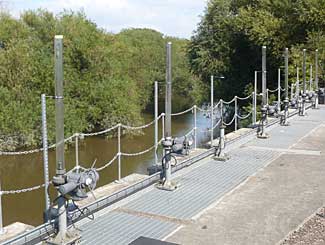|
 No
1 Pump No
1 Pump
The main pump used prior to 2001 is now preserved
on the West Quay near to the small dry dock. It has inlet and
outlet pipes 48 inches in diameter and a discharge valve with
a stroke of 45 inches. When driven by an electric motor, it could supply 3.4
million gallons per hour (15.4 ML/hr). It was installed in a
new building, approximately on its present site in 1962-63 at a
time when there was a need to provide more water to make up
that being extrated from the canal at Purton to supply drinking
water to Bristol. It needed to be primed and started by an operator
on site, but it could be shut down automatically by a timer.
|
|
 No
2 Pump No
2 Pump
Also used prior
to 2001 is an older pump in the pumping engine house on the
other side of the small dry dock. This also has inlet and outlet
pipes 48 inches in diameter, but it has a less powerful motor
and so it is only capable of supplying 2.8 million gallons per
hour. It was installed in 1945 to replace an earlier steam driven
pump in the same building. It had to be primed, started
and shut down by an operator on site. Although not used for
many years, it is retained as an emergency stand-by.
|
|
 Four
New Pumps Four
New Pumps
In 2000-01, four
new electrically driven pumps were installed in a chamber under
the West Quay, and new inlets from the River Severn were constructed
across Severn Rd beyond the fence in the background. The pumps can be started and stopped by the touch of a
button in the adjoining building, or these operations can
be controlled from a remote laptop computer. The monitoring
of canal water level measurements is now done electronically,
and the results can be used to control the operation of the
pumps automatically.
|
|
 Water
Intake Water
Intake
Water is extracted
from the River Severn via eight inlet valves in a compound
between Severn Rd and the river. There is generally much silt
in the water, and this can be seen spreading across the basin
when the pumps are operating. When the tide reverses the
current in the river, the water carries particularly high levels
of silt, and so pumping is avoided during these periods.
Acknowledgements
Thanks
are due to David Viner, Ashley Ellis and Wayne Jones of British
Waterways.
|